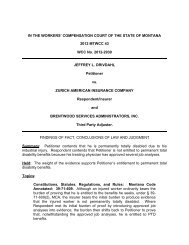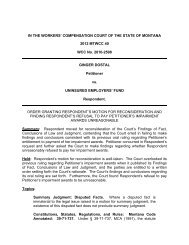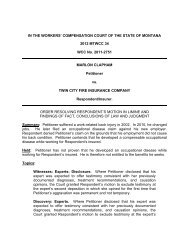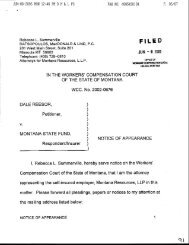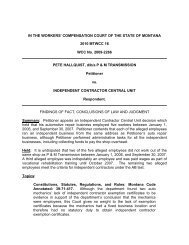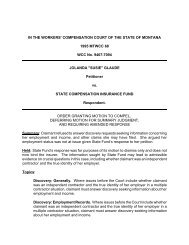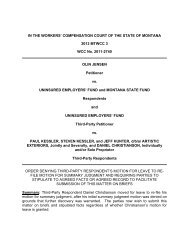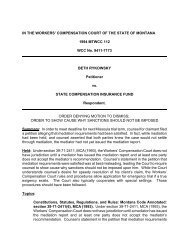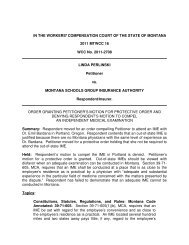Vallance v. MCCF [07/05/06] 2006 MTWCC 26 - Workers ...
Vallance v. MCCF [07/05/06] 2006 MTWCC 26 - Workers ...
Vallance v. MCCF [07/05/06] 2006 MTWCC 26 - Workers ...
You also want an ePaper? Increase the reach of your titles
YUMPU automatically turns print PDFs into web optimized ePapers that Google loves.
IN THE WORKERS’ COMPENSATION COURT OF THE STATE OF MONTANA20<strong>06</strong> <strong>MTWCC</strong> <strong>26</strong>WCC No. 20<strong>05</strong>-1475BRAD VALLANCEPetitionervs.MONTANA CONTRACTOR COMPENSATION FUNDRespondent/Insurer.FINDINGS OF FACT, CONCLUSIONS OF LAW AND JUDGMENTANDORDER DENYING SUMMARY JUDGMENTSummary: Petitioner filed an occupational disease claim after a 2004 MRI showed thathe had herniated disks. However, a 1996 MRI showed those same disks to be bulging.Petitioner has memory difficulties and did not report an accurate history to the physicianswho initially concluded that his back problems were from an occupational disease, as thosephysicians were not aware that Petitioner had suffered several specific traumas to his backboth on the job and outside of work.Held: Petitioner, who has a history of back traumas, including two industrial accidentswhich he did not report to his employer, has failed to prove that his current back problemsstem from an occupational disease rather than an industrial accident or some other specifictrauma.Topics:Witnesses: Credibility. Where Petitioner has epilepsy for which heunderwent brain surgery, and where he and his wife both testified thatPetitioner has difficulty recalling information, particularly in stressfulsituations, and where Petitioner’s testimony at times contradicted itself andhis deposition testimony, Petitioner’s memory problems make him anunreliable historian. Therefore, although the Court does not find Petitioner
to be an incredible witness, the Court does not find Petitioner’s testimony tobe reliable.Employment: Job Duties. Whether Petitioner’s job duties are specificallylabeled heavy duty or moderate duty is less important than the Court’sunderstanding of what Petitioner’s job actually was.Proof: Burden of Proof: Preponderance. Petitioner has not met his burdenof proving by a preponderance of the evidence that he suffers from anoccupational disease where his doctors were not provided with a sufficienthistory of his back problems, and where these doctors, upon learning ofadditional injuries and symptoms recorded in Petitioner’s medical records,could no longer assert that Petitioner’s back problems were more probablythan not caused by an occupational disease.Constitutions, Statutes, Regulations, and Rules: Montana CodeAnnotated: 39-71-119. Distinct, identifiable incidents which satisfy the injurydefinition of § 39-71-119, MCA, fall under the <strong>Workers</strong>’ Compensation Act.Whitlock v. Fremont Indus. Indem. Co., 2002 <strong>MTWCC</strong> 12, 28, 31.Constitutions, Statutes, Regulations, and Rules: Montana CodeAnnotated: 39-72-408. Occupational diseases are considered to arise outof employment if there is a direct causal connection between the conditionsunder which the work is performed and the occupational disease, the diseasecan be seen to have followed as a natural incident of the work as a result ofthe exposure occasioned by the nature of the employment, the disease canbe fairly traced to the employment as the proximate cause, and the diseasecomes from a hazard to which workers would not have been equally exposedoutside of the employment. In Petitioner’s case, he is simply unable to provethat his back condition was caused by an occupational disease rather thanby a specific trauma or industrial accident. 1 The trial in this matter was held on Wednesday, February 15, 20<strong>06</strong>, in Helena,Montana. Petitioner Brad <strong>Vallance</strong> was present and represented by Norman H. Grosfield.Respondent was represented by Bradley J. Luck. 2 Exhibits: Exhibits 1 through 18 were admitted without objection. Exhibit 11 is acomposite exhibit of the exhibits previously filed in support of Respondent’s motion forsummary judgment, attached to the foundational affidavit of Respondent’s counsel. TheFindings of Fact, Conclusions of Law and Judgment and Order Denying Summary Judgment - Page 2
Court also took judicial notice of the proceedings in WCC No. 20<strong>05</strong>-1323, which involvesthe same parties and is also before this Court. 1 3 Witnesses and Depositions: The depositions of Dr. Gary Rapaport and Dr. JohnMichelotti were taken and submitted to the Court. Petitioner, Michelle <strong>Vallance</strong>, James D.Silvan, and Robert Kruckenberg were sworn and testified at trial. 4 Issues Presented: The Pretrial Order states the following contested issue of law: 4a Whether Petitioner has suffered an occupational disease compensableunder the Montana Occupational Disease Act. 2 5 Respondent filed a motion for summary judgment on the grounds that Petitioner’sclaim is barred by the statute of limitations. The Court took the matter under advisementpending trial, and also rules on this issue below.FINDINGS OF FACT 6 The parties stipulated that the Court could take judicial notice of the record in WCCNo. 20<strong>05</strong>-1323, a claim involving Petitioner and Respondent which was heard by this Courton November 30 and December 7, 20<strong>05</strong>, and had a decision pending at the time of thistrial. The Court has done so. The Findings set forth below take into account the record ofthat case. 7 At the outset, this Court finds that Petitioner has memory deficits. 3 Petitioner hasepilepsy for which he underwent brain surgery in 1987. 4 Both Petitioner and his wifetestified that Petitioner has difficulty recalling information, particularly when he is in astressful situation. 5 Ms. <strong>Vallance</strong> explained that Petitioner has difficulty recalling mundanedetails in everyday life. 61 Decision at 20<strong>06</strong> <strong>MTWCC</strong> 15.2 (Pretrial Order at 2.)3 Trial Test.4 Exhibit 17 at 1.5 Trial Test.6 Id.Findings of Fact, Conclusions of Law and Judgment and Order Denying Summary Judgment - Page 3
8 Petitioner explained that at the time of his deposition, 7 he was stressed and thiscaused him to become confused and perhaps answer some questions inaccurately. Heacknowledged that he made no corrections to his deposition when later provided with theopportunity to do so. 8 9 The Court finds Petitioner’s explanation regarding his memory deficits in histestimony both in deposition and at trial to be credible. 10 Petitioner was an employee of Dick Anderson Construction (DAC) from June 1996through February 20<strong>05</strong>. 9 11 Petitioner filed an occupational disease claim for a back condition on April 27,20<strong>05</strong>. 10 12 DAC is enrolled under Compensation Plan No. 1 of the Montana <strong>Workers</strong>’Compensation Act, the insurer being the Montana Contractor Compensation Fund(Respondent or <strong>MCCF</strong>). 11 13 Pursuant to an Order of the Montana Department of Labor and Industry, Petitionerwas examined by Dr. Gary Rapaport, who issued his opinion on June 16, 20<strong>05</strong>. 12 14 Respondent denied liability for the occupational disease claim on July 20, 20<strong>05</strong>. 13 15 The mediation procedures set forth in the Occupational Disease Act have beencomplied with. 147 Petitioner’s deposition was entered into the record as part of his other pending claim, of which this Court takesjudicial notice.8 Trial Test.9 Pretrial Order at 2, Uncontested Fact, 1.10 Pretrial Order at 2, Uncontested Fact, 2.11 Pretrial Order at 2, Uncontested Fact, 3.12 Pretrial Order at 2, Uncontested Fact, 4.13 Pretrial Order at 2, Uncontested Fact, 5.14 Pretrial Order at 2, Uncontested Fact, 6.Findings of Fact, Conclusions of Law and Judgment and Order Denying Summary Judgment - Page 4
16 In 1993, Petitioner filed a workers’ compensation claim for a back injury whileworking for the City of Helena. 15 Petitioner was off work for approximately two weeks,during which time he received payments for temporary total disability. 16 Petitioner testifiedthat he does not recall filing a workers’ compensation claim with the City of Helena in 1993,nor does he recall having two weeks off of work or receiving temporary total disability fora back injury. 17 17 While working for DAC, Petitioner received an employee manual which includedinformation about workers’ compensation and instructed employees to report all accidents,including minor injuries and “near misses,” to a supervisor. Petitioner signed anacknowledgment that he had received and read the manual, and that he was responsiblefor knowing the manual’s contents. 18 18 On September 4, 1996, Petitioner visited Dr. Charles B. Anderson for an annualcheckup. Dr. Anderson reported that Petitioner complained of intermittent numbness in hisfeet. Petitioner told Dr. Anderson that the problem had been going on for two or threeyears. Petitioner further told Dr. Anderson that he had been experiencing low back painfor four or five years, ever since he strained his back while attempting to push asnowmobile out of some snow. 19 19 Petitioner testified that although he recalls having an appointment with Dr. Andersonin 1996, he has no memory of back pain nor any memory of injuring his back attemptingto move a snowmobile. He does not recall telling Dr. Anderson that he experiencednumbness in his feet. 20 20 On September 9, 1996, an MRI was performed on Petitioner’s lumbar spine.Petitioner was diagnosed with a central and left-sided disk bulge at both the L4-5 and L5-S1 levels. 2115 Ex. 13.16 Ex. 14.17 Trial Test.18 Ex. 11 (11).19 Ex. 10 at 1.20 Trial Test.21 Ex. 7.Findings of Fact, Conclusions of Law and Judgment and Order Denying Summary Judgment - Page 5
21 Petitioner testified that in 1996, he had an incident while lifting concrete forms atDAC which had a “severe effect” on his back. He agreed that he had recovered “some”from that incident, but that his symptoms since then have been sometimes better,sometimes worse. Petitioner did not file a workers’ compensation claim for the liftingincident. He testified that it was because he did not know about workers’ compensation atthe time. 22 22 It is unclear from the record before this Court whether this lifting incident occurredbefore or after Petitioner’s September 1996 MRI. Although Petitioner testified in hisdeposition that the MRI occurred after he injured his back during a lifting incident, 23 Dr.Anderson’s September 4, 1996, progress note does not mention this occurrence althoughit details back injuries from several years before. 24 23 At trial, Petitioner provided detailed descriptions of the various tasks he completedfor DAC when he first began working as a mechanic/laborer in June 1996. He explainedthat his mechanical work included repairing and replacing hydraulic systems and servicingheavy equipment, and he described how he would perform this work. He listed the labortasks he performed in the DAC “yard,” the frequency with which he performed each task,and described how one would undertake these tasks, including the weight of items liftedand what types of mechanical aids were available to assist with each task. These tasksincluded stacking, loading, and delivering concrete forms, stacking rebar, sorting plywood,loading and unloading hardware from job site trailers, sandblasting, and loading andunloading concrete blankets, fencing, water pumps, power tools, and a variety of equipmentwhich DAC used on work sites. Petitioner testified that although he utilized forklifts andother labor-assisting devices, his daily job activities entailed a great deal of lifting, bending,squatting, and carrying. 25 24 James D. Silvan, Shop Manager, has worked for DAC for seventeen years and wasPetitioner’s supervisor for the entire time Petitioner worked for DAC. Mr. Silvan testifiedthat Petitioner was a good worker and that Mr. Silvan considered them to be friends. Heacknowledged that he was uncomfortable testifying against Petitioner. <strong>26</strong> 25 The Court finds Mr. Silvan to be a credible witness.22 <strong>Vallance</strong> Dep. at 42; Trial Test.23 <strong>Vallance</strong> Dep. at 40-41.24 Ex. 10 at 1.25 Trial Test.<strong>26</strong> Id.Findings of Fact, Conclusions of Law and Judgment and Order Denying Summary Judgment - Page 6
<strong>26</strong> Mr. Silvan testified that there was always help available for heavy or awkward tasks,and Mr. Silvan often worked alongside Petitioner. Mr. Silvan explained that equipmentsuch as forklifts, a pallet jack, and various carts were available for lifting and moving heavyitems. Although he characterized how frequently Petitioner performed certain tasks as lessfrequently than Petitioner asserted, Mr. Silvan generally agreed with Petitioner’senumeration of the tasks which he performed as part of his job duties. However, manytasks which Petitioner characterized as heavy labor – such as operating a forklift, servicingheavy machinery, and unloading equipment returned from job sites – Mr. Silvan classifiedas moderate to light labor. Mr. Silvan testified that there were many heavy items whichneeded to be lifted or carried a short distance, but Petitioner would ask for assistance inlifting heavy items. He testified that many of the tasks Petitioner described would onlyoccur one to three times per year. Mr. Silvan stated that he considered Petitioner’s job tobe moderate to light labor because there was always assistance, either mechanical orhuman or both, for lifting heavy objects or completing awkward tasks. 27 27 Whether Petitioner’s job duties are specifically labeled heavy duty or moderate dutyis less important than the Court’s understanding of what Petitioner’s job actually was.Based on the testimony presented to it, the Court finds that Petitioner’s job was largelymoderate duty with some regularly-assigned tasks being either light duty or heavy duty. 28 In January 1997, Petitioner slipped and fell on ice while at work. 28 He did not reportthe fall and he did not file a workers’ compensation claim. Petitioner explained that he didnot file a claim because he was unaware of workers’ compensation. 29 29 Ms. <strong>Vallance</strong> recalls Petitioner telling her that he fell on the ice at DAC inapproximately 1996. She stated that he was “sore” afterwards, but that the fall did notseem significant. 30 30 Mr. Silvan testified that he remembered that in 1998 or 1999, Petitioner told him thathe fell on some ice at work. 3127 Id.28 <strong>Vallance</strong> Dep. 8:16 - 9:2; Trial Test.29 <strong>Vallance</strong> Dep. 20:18 - 21:11; Trial Test.30 Trial Test. Although Ms. <strong>Vallance</strong> recalls the fall as occurring in 1996, since Petitioner did not begin workingfor DAC until June 1996, the fall could not have occurred prior to Petitioner’s September 1996 MRI.31 Trial Test.Findings of Fact, Conclusions of Law and Judgment and Order Denying Summary Judgment - Page 7
31 In his deposition, Petitioner asserted that the fall on the ice was the start of his backproblems. Specifically, Petitioner testified as follows:Q. Tell me about the onset of those back problems you believe were causedby your work at Dick Anderson Construction.A. When I started having that problem with my back and having tocontinually do the type of work that I was doing, it gradually just got worse.Q. But it started in 1997?A. Uh-huh.. . . .Q. Any specific event cause it?A. I slipped on the ice once.Q. Tell me about that.A. Out there in back of the shop, it puddles, and there was nothing but abunch of ice out there. I slipped on the ice and fell on my back, and that waspretty sore.Q. Do you know when that was?A. The exact date, I don’t. It was in the winter, probably in January orFebruary.Q. Of what year?A. ’97.. . . .Q. You had no back problems before that fall on the ice in about January ’97at Dick Anderson Construction?A. Never.Q. Never?Findings of Fact, Conclusions of Law and Judgment and Order Denying Summary Judgment - Page 8
A. Nothing, no back problems. 32 32 The medical records contradict Petitioner’s recollection. He had a workers’compensation claim for a back injury in 1993. 33 In September 1996, he reported a backstrain and back pain going back four or five years from a snowmobile incident. 34 Petitioneralso later reported that he strained his back while moving concrete forms prior to the fallon the ice. 35 33 In August 1999, Petitioner filed a workers’ compensation claim for a muscle strainin his lower back. 36 He received one acupuncture treatment and was released to workwithout restrictions. 37 Petitioner could not explain how, if he was unaware of workers’compensation when he fell on the ice in January 1997, he became aware of workers’compensation at the time of this injury. 38 34 Petitioner’s testimony at times contradicted itself and at times contradicted hisdeposition testimony. Much of this, in the Court’s view, can be explained by Petitioner’smemory difficulties about which both he and his wife testified. Irrespective of Petitioner’smemory problems, however, much of Petitioner’s history of back problems and treatmentcan be discerned from empirical evidence. As noted above, there is ample evidence tosupport a finding that Petitioner has memory problems, whether as a result of his epilepsyor his brain surgery. Unfortunately, these memory problems make Petitioner an unreliablehistorian. Therefore, although the Court does not find Petitioner to be an incrediblewitness, the Court does not find Petitioner’s testimony to be reliable. 35 Petitioner occasionally complained to Mr. Silvan that his back was sore and at timeshe wore a velcro back support at work. Mr. Silvan recalled telling Petitioner on three or fouroccasions that he should file a workers’ compensation claim to protect himself, butPetitioner did not want to file a claim. 3932 <strong>Vallance</strong> Dep. 8:4 - 9:14.33 Exs. 12-13.34 Ex. 10.35 <strong>Vallance</strong> Dep. at 40-43.36 Ex. 11 (12).37 Ex. 11 (13).38 Trial Test.39 Id.Findings of Fact, Conclusions of Law and Judgment and Order Denying Summary Judgment - Page 9
36 Ms. <strong>Vallance</strong> recalled that it was during the last year and a half to two years ofPetitioner’s employment at DAC that his back problems noticeably worsened. 40 37 The Court finds Ms. <strong>Vallance</strong> to be a credible witness. 38 Robert Kruckenberg is now the Safety Manager for Holsum, Inc. From August 1998until October 20<strong>05</strong>, he was Safety Director for DAC. 41 The Court finds Mr. Kruckenberg tobe a credible witness. 39 Mr. Kruckenberg testified that DAC has clear policies which outline workplaceaccident and injury reporting. 42 On November 22, 2004, Petitioner informed Mr.Kruckenberg that he had a herniated disk and that he needed to go on light duty at work.Mr. Kruckenberg asked Petitioner if he wanted to file a workers’ compensation claim, andPetitioner replied that he did not believe his back problems were work-related. 43 Mr.Kruckenberg encouraged Petitioner to file a workers’ compensation claim if Petitionerbelieved his back problems might be work-related, and Petitioner declined to do so. 44Medical Testimony 40 At trial, Petitioner was unable to recall his history of back problems as related to thevarious doctors he has seen since 1996. He could not recall why he told Dr. Michelotti thathis back and leg problems started in late 2004. He could not recall whether he told Dr.Mulgrew that he experienced severe back pain for two or three years prior to October 2004.He could not recall whether he told Dr. Rapaport that his job aggravated his back problems.He could not recall discussing his previous MRI with Dr. Michelotti. He also could not recallwhy he did not tell Dr. Michelotti about the snowmobile incident, the 1996 lifting incident,or the 1997 fall on the ice. 45 41 Dr. Rapaport conducted a panel examination of Petitioner. He is board certified inoccupational medicine and as a medical review officer. 4640 Id.41 Id.42 Id.43 Ex. 12 at 1; Trial Test.44 Trial Test.45 Id.46 Rapaport Dep. 6:4-13.Findings of Fact, Conclusions of Law and Judgment and Order Denying Summary Judgment - Page 10
42 In his deposition, Dr. Rapaport explained that the diagnosis of cumulative traumais on the basis of history. 47 Dr. Rapaport testified that he did not know that Petitioner hadcomplained of back pain prior to his fall on the ice, and that the history Dr. Rapaport haddid not include the snowmobile incident, the 1996 lifting incident, or any other incidentwhich predated the fall on the ice. 48 Dr. Rapaport was unaware that Petitioner had filed aworkers’ compensation claim for a back injury in 1993. 49 He also had not seen Dr.Anderson’s 1996 progress report which noted that Petitioner had low back problems forfour or five years. Dr. Rapaport was unaware that Petitioner had ever reported numbnessin his feet. 50 43 In his IME, Dr. Rapaport reported that Petitioner informed him that he fell on the icein 1996, and that he subsequently had an MRI performed. At the time of the IME, Dr.Rapaport believed that the fall on the ice preceded the MRI. He also believed, based uponthe history as related to him by Petitioner, that Petitioner suffered no previous orsubsequent injuries to his back. Dr. Rapaport noted that the 2004 MRI revealed a diskherniation which was not present at the time of the 1996 MRI. Since Dr. Rapaport wasunder the mistaken impression that the 1996 MRI was subsequent to Petitioner’s fall on theice, and since he was unaware at the time of the IME of Petitioner’s 1996 lifting injury andhis August 16, 1999, back injury, Dr. Rapaport concluded that the disk herniation could onlybe attributed to an occupational disease caused by Petitioner’s strenuous job activities. Inother words, Dr. Rapaport’s information was that Petitioner’s only potentially back injuringaccident was the fall on the ice, and Dr. Rapaport believed the 1996 MRI occurred after thefall on the ice, thus eliminating the fall as the possible cause of Petitioner’s herniated disk. 44 Dr. Rapaport acknowledged that Petitioner’s “credibility is an issue,” 51 and furtherstated, “I think the existence of back pain previously and additional potential injury maysuggest that the condition may have developed prior to 1996 . . . .” 52 45 Dr. Rapaport testified that, based upon his new knowledge about Petitioner’smedical history, he could not say whether it was more probable that Petitioner’s backproblems stemmed from one of Petitioner’s accidents or from his occupation. He testified47 Rapaport Dep. 10:21-22.48 Rapaport Dep. 13:25 - 14:1; 18:9-12; 18:18 - 20:4.49 Rapaport Dep. 24:2-7.50 Rapaport Dep. 28:10 - 31:24.51 Rapaport Dep. 33:8.52 Rapaport Dep. 43:15-18.Findings of Fact, Conclusions of Law and Judgment and Order Denying Summary Judgment - Page 11
that, based upon the history he had just learned, “I don’t know if I could say that[Petitioner’s back condition was the result of an occupational disease] on a more probablethan not basis.” 53 46 Dr. Michelotti is a board certified orthopedic surgeon. 54 Petitioner first visited Dr.Michelotti on January 18, 20<strong>05</strong>, to get a second opinion about the knee injury which wasthe subject of Petitioner’s other workers’ compensation proceeding. 55 Petitioner continuedto see Dr. Michelotti on a regular basis, with most of Dr. Michelotti’s treatment focusing onPetitioner’s knees. 56 Dr. Michelotti admitted he did not overtly consider causation in relationto Petitioner’s back condition. 57 47 Dr. Michelotti testified that Petitioner did not describe his work activities to him, 58 andthat he did not know if heavy labor would necessarily aggravate a herniated disk. 59 48 Dr. Michelotti’s information about Petitioner’s medical history included the report ofPetitioner’s 2004 MRI and the history Petitioner provided. 60 Petitioner did not inform Dr.Michelotti about his 1993 back injury, 61 the snowmobile incident, 62 the numbness he53 Rapaport Dep. 47:1-2.54 Michelotti Dep. 4:23-25.55 Ex. 5 at 4.56 Michelotti Dep. 21:3.57 Michelotti Dep. 20:24 - 21:3.58 Michelotti Dep. 13:8-11.59 Michelotti Dep. 16:25 - 17.2.60 Michelotti Dep. 24:9-25.61 Michelotti Dep. 34:1-5.62 Michelotti Dep. 34:6-14.Findings of Fact, Conclusions of Law and Judgment and Order Denying Summary Judgment - Page 12
experienced in his feet, 63 the concrete form lifting incident in 1996, 64 the fall on the ice in1997, 65 nor the fact that Petitioner regularly saw a chiropractor in 2000 and 2003. 66 49 Dr. Michelotti acknowledged that cumulative trauma injuries are often diagnosedprimarily on the basis of history, 67 and that physicians are dependent upon patientsproviding complete and accurate histories. 68 He agreed that the history Petitioner did notprovide would have been “important” in making a diagnosis. 69 50 Dr. Michelotti admitted that Petitioner’s 1997 fall on the ice could have caused hisbulging disk to rupture. 70 He further admitted that the symptoms Petitioner has experiencedsince that fall are consistent with the fall and the other traumas. 71 51 Based upon the new historical information provided, Dr. Michelotti admitted that hedid not know whether Petitioner’s present back condition was more probably caused byongoing work activities or by a specific trauma or traumas. 72 52 Both Dr. Rapaport and Dr. Michelotti testified that they reached their conclusionsthat Petitioner suffered from an occupational disease without the benefit of Petitioner’shistory regarding the various incidents in which he may have injured his back. Uponlearning of some of Petitioner’s history of back injuries, both doctors admitted that theywere no longer convinced that Petitioner’s present back condition was attributable to anoccupational disease rather than to a specific injury.63 Michelotti Dep. 34:23 - 35:5.64 Michelotti Dep. 25:14-17.65 Id.66 Michelotti Dep. 42:16 - 43:10.67 Michelotti Dep. <strong>26</strong>:5-8.68 Michelotti Dep. <strong>26</strong>:25 - 27:11.69 Michelotti Dep. 32:4-12.70 Michelotti Dep. 49:7-13.71 Michelotti Dep. 50:2-9.72 Michelotti Dep. 55:23 - 56:3.Findings of Fact, Conclusions of Law and Judgment and Order Denying Summary Judgment - Page 13
CONCLUSIONS OF LAW 53 The law in effect on an employee’s last day of work governs the resolution of a claimunder the Occupational Disease Act. 73 Since Petitioner’s last day of employment with DACwas in February 20<strong>05</strong>, the 2003 statutes control. 74 54 Petitioner bears the burden of proving by a preponderance of the evidence that heis entitled to the benefits he seeks. 75 55 Petitioner has not met his burden of proving by a preponderance of the evidencethat he suffers from an occupational disease. Neither Dr. Michelotti nor Dr. Rapaport wasprovided a sufficient history of Petitioner’s back problems, and both doctors, upon learningof additional injuries and symptoms recorded in Petitioner’s medical records, could nolonger assert that Petitioner’s back problems were more probably than not caused by anoccupational disease. 56 Petitioner’s own testimony is that he had two specific incidents at work which causedinjury to his back, but for which he filed no compensation claims. Distinct, identifiableincidents which satisfy the injury definition of § 39-71-119, MCA 76 , fall under the <strong>Workers</strong>’Compensation Act. 77 57 In Whitlock, this Court held that three distinct identifiable but unreported incidentswhich the claimant suffered at work did not transform into an occupational disease claim. 78In Whitlock, the claimant ultimately prevailed under the latent injury doctrine because,although she experienced some aching in her shoulder after each incident, it was not of amagnitude which either inhibited her work or led her to believe she needed medical care. 7973Grenz v. Fire & Cas. of Conn., 278 Mont. <strong>26</strong>8, 272, 924 P.2d <strong>26</strong>4, <strong>26</strong>7 (1996); Hardgrove v.Transportation Ins. Co., 2004 MT 340, 2, 324 Mont. 238, 103 P.3d 999.74 All Montana statute citations in this document refer to the 2003 version unless otherwise noted.75Ricks v. Teslow Consol., 162 Mont. 469, 512 P.2d 1304 (1973); Dumont v. Wickens Bros. Constr.Co., 183 Mont. 190, 598 P.2d 1099 (1979).76 Specifically, § 39-71-119(2), MCA, explains that an injury is caused by an accident, and an accident is anunexpected traumatic incident or unusual strain identifiable by time and place of occurrence and part of the body affected,and caused by a specific event on a single day or during a single work shift.77 Whitlock v. Fremont Indus. Indem. Co., 2002 <strong>MTWCC</strong> 12, 28.78 Id.79 Whitlock, 31.Findings of Fact, Conclusions of Law and Judgment and Order Denying Summary Judgment - Page 14
In the case before us, Petitioner does not assert a latent injury claim, nor do the facts lendthemselves to such a claim. 58 While Petitioner asserted that his job should be classified as heavy labor,Respondent argued Petitioner’s job was more properly classified as a moderate or lightdutyconstruction job. Regardless of how Petitioner’s job may be classified, however,Petitioner has failed to establish causation. 59 Occupational diseases are considered to arise out of employment if there is a directcausal connection between the conditions under which the work is performed and theoccupational disease, the disease can be seen to have followed as a natural incident of thework as a result of the exposure occasioned by the nature of the employment, the diseasecan be fairly traced to the employment as the proximate cause, and the disease comesfrom a hazard to which workers would not have been equally exposed outside of theemployment. 80 In Petitioner’s case, he is simply unable to prove that his back conditionwas caused by an occupational disease rather than by a specific trauma or industrialaccident.RESPONDENT’S MOTION FOR SUMMARY JUDGMENT 60 Prior to trial, Respondent moved for summary judgment in this matter on thegrounds that Petitioner’s claim was barred by the statute of limitations, pursuant to § 39-72-403(1), MCA, since Respondent alleges that Petitioner, in arguing that his job aggravatedhis back problems from 1996 through 2003, should have filed his claim sooner. The Courtreserved its ruling on this motion until after trial. The Court, after hearing this case, hasdetermined that Petitioner’s failure to prove causation is dispositive. Since the Court’sruling is based on the merits of this case, it need not reach Respondent’s legal argument.JUDGMENT 61 Petitioner’s back condition is not an occupational disease compensable under theMontana Occupational Disease Act. The request for relief prayed for in Petitioner’s Petitionfor Hearing is therefore DENIED. 62 Respondent’s Motion for Summary Judgment is DENIED as moot. 63 This JUDGMENT is certified as final for purposes of appeal.80 § 39-72-408(1), MCA.Findings of Fact, Conclusions of Law and Judgment and Order Denying Summary Judgment - Page 15
64 Any party to this dispute may have twenty days in which to request reconsiderationfrom these FINDINGS OF FACT, CONCLUSIONS OF LAW AND JUDGMENT ANDORDER DENYING SUMMARY JUDGMENT.DATED in Helena, Montana, this 5 th day of July, 20<strong>06</strong>.(SEAL)/s/ JAMES JEREMIAH SHEAJUDGEc: Norman H. GrosfieldBradley J. LuckSubmitted: February 24, 20<strong>06</strong>Findings of Fact, Conclusions of Law and Judgment and Order Denying Summary Judgment - Page 16


![Vallance v. MCCF [07/05/06] 2006 MTWCC 26 - Workers ...](https://img.yumpu.com/48724322/1/500x640/vallance-v-mccf-07-05-06-2006-mtwcc-26-workers-.jpg)
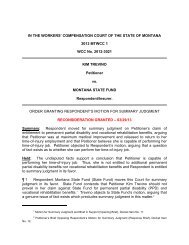
![Bustell v. AIG Claims Service, Inc. [05/03/05] 2005 MTWCC 23](https://img.yumpu.com/49777654/1/190x245/bustell-v-aig-claims-service-inc-05-03-05-2005-mtwcc-23.jpg?quality=85)
